Nutritional Assessment: Consumption of Fruits and Vegetables
VerifiedAdded on 2023/06/13
|9
|2335
|471
AI Summary
This report discusses the consumption of fruits and vegetables, Australian dietary guidelines, and social and cultural determinants that affect the intake of fruits and vegetables. It includes a food and beverage diary for 3 days, required quantities of fruits and vegetables, and strategies to improve consumption. The report also includes a discussion of 2 dietary changes, Australian dietary summary quiz score, and social and cultural determinants that affect the intake of fruits and vegetables.
Contribute Materials
Your contribution can guide someone’s learning journey. Share your
documents today.
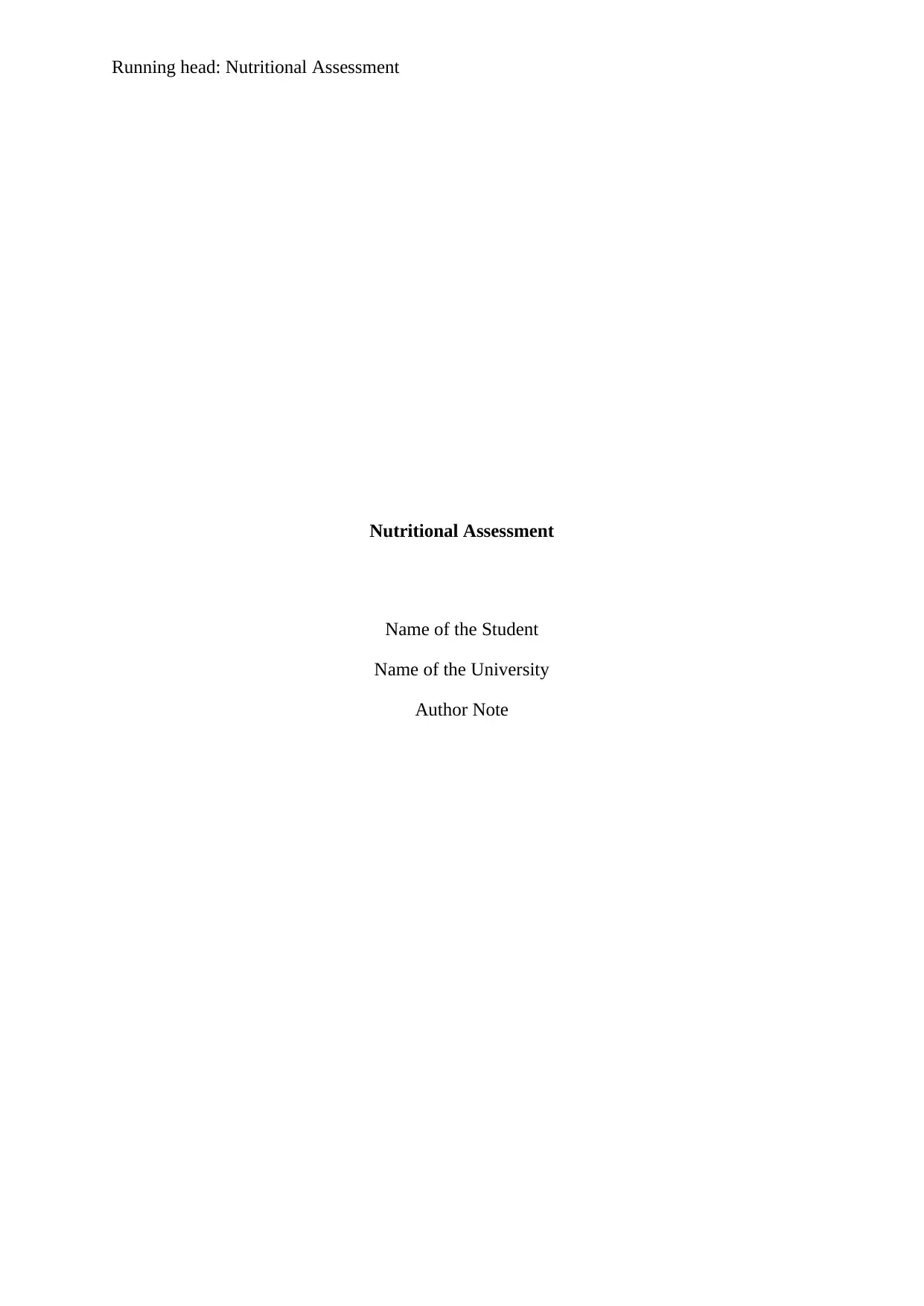
Running head: Nutritional Assessment
Nutritional Assessment
Name of the Student
Name of the University
Author Note
Nutritional Assessment
Name of the Student
Name of the University
Author Note
Secure Best Marks with AI Grader
Need help grading? Try our AI Grader for instant feedback on your assignments.
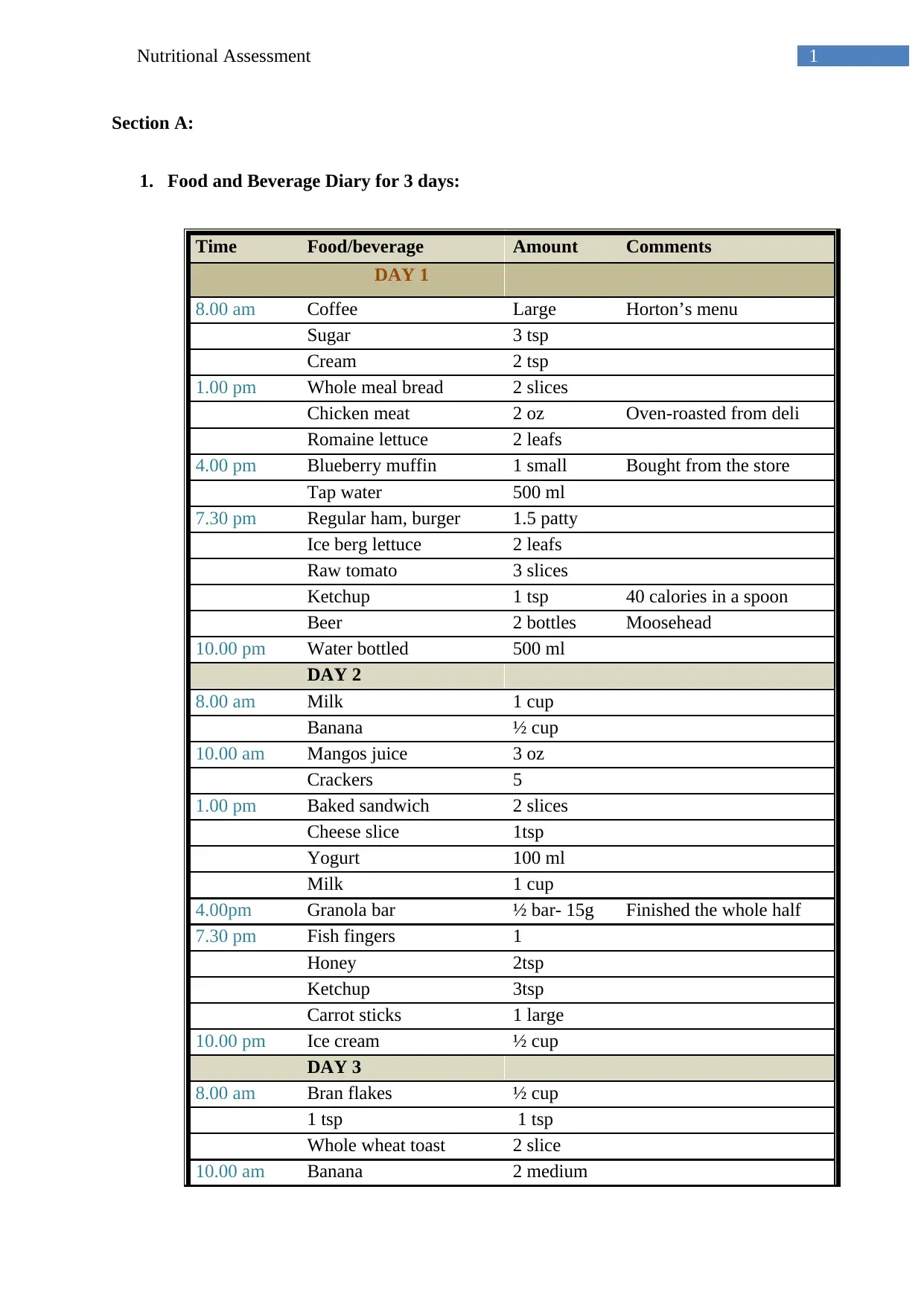
1Nutritional Assessment
Section A:
1. Food and Beverage Diary for 3 days:
Time Food/beverage Amount Comments
DAY 1
8.00 am Coffee Large Horton’s menu
Sugar 3 tsp
Cream 2 tsp
1.00 pm Whole meal bread 2 slices
Chicken meat 2 oz Oven-roasted from deli
Romaine lettuce 2 leafs
4.00 pm Blueberry muffin 1 small Bought from the store
Tap water 500 ml
7.30 pm Regular ham, burger 1.5 patty
Ice berg lettuce 2 leafs
Raw tomato 3 slices
Ketchup 1 tsp 40 calories in a spoon
Beer 2 bottles Moosehead
10.00 pm Water bottled 500 ml
DAY 2
8.00 am Milk 1 cup
Banana ½ cup
10.00 am Mangos juice 3 oz
Crackers 5
1.00 pm Baked sandwich 2 slices
Cheese slice 1tsp
Yogurt 100 ml
Milk 1 cup
4.00pm Granola bar ½ bar- 15g Finished the whole half
7.30 pm Fish fingers 1
Honey 2tsp
Ketchup 3tsp
Carrot sticks 1 large
10.00 pm Ice cream ½ cup
DAY 3
8.00 am Bran flakes ½ cup
1 tsp 1 tsp
Whole wheat toast 2 slice
10.00 am Banana 2 medium
Section A:
1. Food and Beverage Diary for 3 days:
Time Food/beverage Amount Comments
DAY 1
8.00 am Coffee Large Horton’s menu
Sugar 3 tsp
Cream 2 tsp
1.00 pm Whole meal bread 2 slices
Chicken meat 2 oz Oven-roasted from deli
Romaine lettuce 2 leafs
4.00 pm Blueberry muffin 1 small Bought from the store
Tap water 500 ml
7.30 pm Regular ham, burger 1.5 patty
Ice berg lettuce 2 leafs
Raw tomato 3 slices
Ketchup 1 tsp 40 calories in a spoon
Beer 2 bottles Moosehead
10.00 pm Water bottled 500 ml
DAY 2
8.00 am Milk 1 cup
Banana ½ cup
10.00 am Mangos juice 3 oz
Crackers 5
1.00 pm Baked sandwich 2 slices
Cheese slice 1tsp
Yogurt 100 ml
Milk 1 cup
4.00pm Granola bar ½ bar- 15g Finished the whole half
7.30 pm Fish fingers 1
Honey 2tsp
Ketchup 3tsp
Carrot sticks 1 large
10.00 pm Ice cream ½ cup
DAY 3
8.00 am Bran flakes ½ cup
1 tsp 1 tsp
Whole wheat toast 2 slice
10.00 am Banana 2 medium
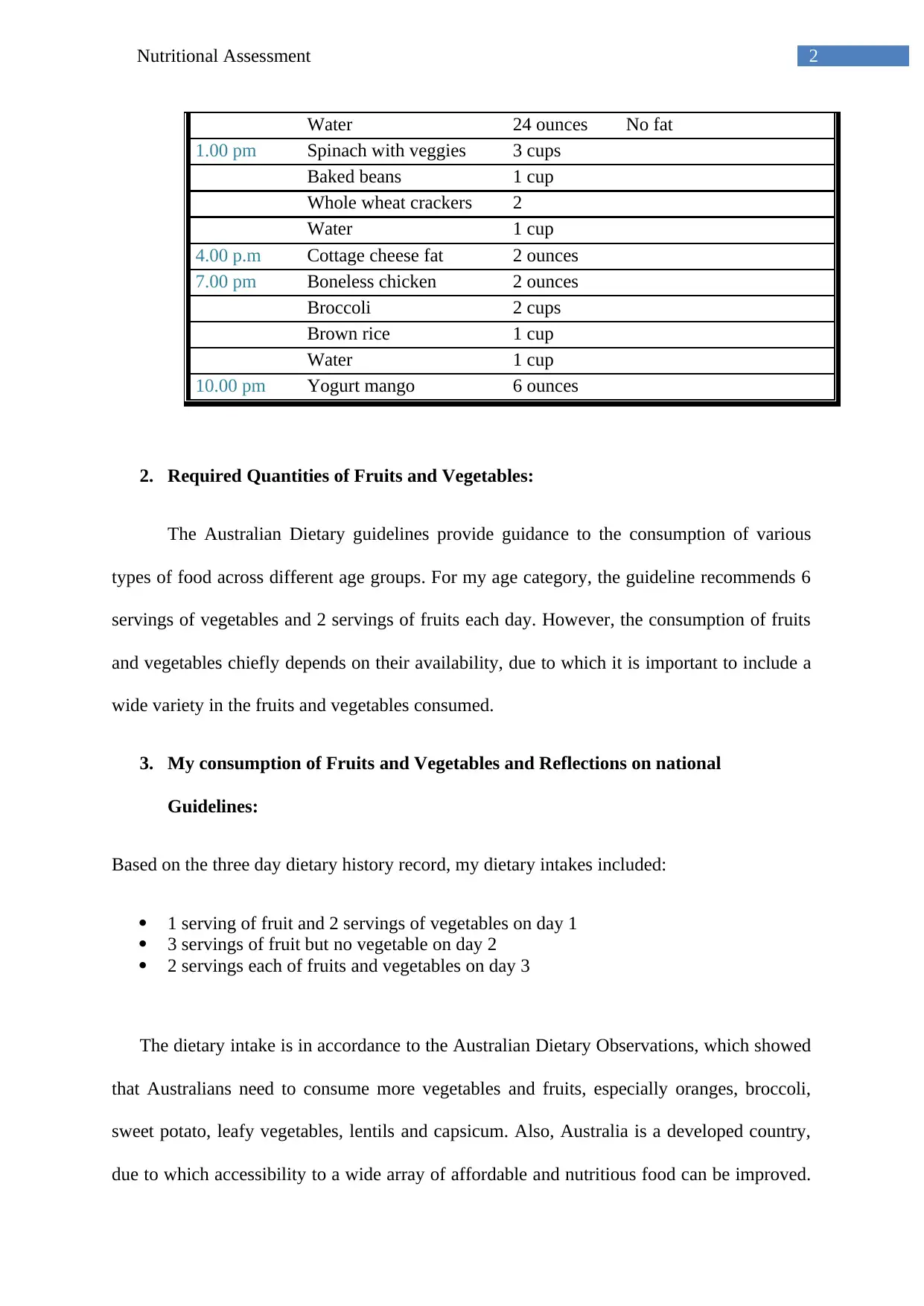
2Nutritional Assessment
Water 24 ounces No fat
1.00 pm Spinach with veggies 3 cups
Baked beans 1 cup
Whole wheat crackers 2
Water 1 cup
4.00 p.m Cottage cheese fat 2 ounces
7.00 pm Boneless chicken 2 ounces
Broccoli 2 cups
Brown rice 1 cup
Water 1 cup
10.00 pm Yogurt mango 6 ounces
2. Required Quantities of Fruits and Vegetables:
The Australian Dietary guidelines provide guidance to the consumption of various
types of food across different age groups. For my age category, the guideline recommends 6
servings of vegetables and 2 servings of fruits each day. However, the consumption of fruits
and vegetables chiefly depends on their availability, due to which it is important to include a
wide variety in the fruits and vegetables consumed.
3. My consumption of Fruits and Vegetables and Reflections on national
Guidelines:
Based on the three day dietary history record, my dietary intakes included:
1 serving of fruit and 2 servings of vegetables on day 1
3 servings of fruit but no vegetable on day 2
2 servings each of fruits and vegetables on day 3
The dietary intake is in accordance to the Australian Dietary Observations, which showed
that Australians need to consume more vegetables and fruits, especially oranges, broccoli,
sweet potato, leafy vegetables, lentils and capsicum. Also, Australia is a developed country,
due to which accessibility to a wide array of affordable and nutritious food can be improved.
Water 24 ounces No fat
1.00 pm Spinach with veggies 3 cups
Baked beans 1 cup
Whole wheat crackers 2
Water 1 cup
4.00 p.m Cottage cheese fat 2 ounces
7.00 pm Boneless chicken 2 ounces
Broccoli 2 cups
Brown rice 1 cup
Water 1 cup
10.00 pm Yogurt mango 6 ounces
2. Required Quantities of Fruits and Vegetables:
The Australian Dietary guidelines provide guidance to the consumption of various
types of food across different age groups. For my age category, the guideline recommends 6
servings of vegetables and 2 servings of fruits each day. However, the consumption of fruits
and vegetables chiefly depends on their availability, due to which it is important to include a
wide variety in the fruits and vegetables consumed.
3. My consumption of Fruits and Vegetables and Reflections on national
Guidelines:
Based on the three day dietary history record, my dietary intakes included:
1 serving of fruit and 2 servings of vegetables on day 1
3 servings of fruit but no vegetable on day 2
2 servings each of fruits and vegetables on day 3
The dietary intake is in accordance to the Australian Dietary Observations, which showed
that Australians need to consume more vegetables and fruits, especially oranges, broccoli,
sweet potato, leafy vegetables, lentils and capsicum. Also, Australia is a developed country,
due to which accessibility to a wide array of affordable and nutritious food can be improved.
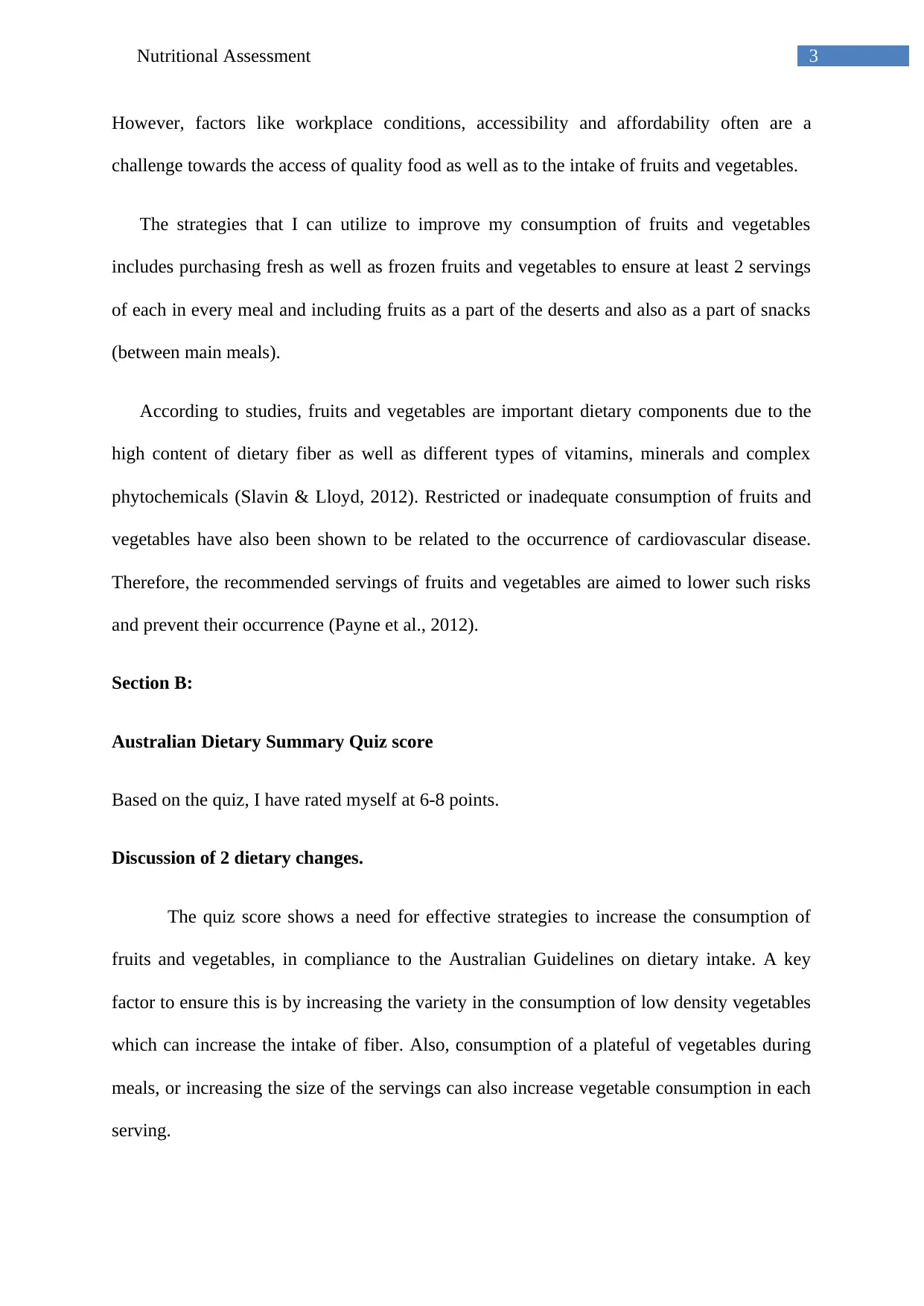
3Nutritional Assessment
However, factors like workplace conditions, accessibility and affordability often are a
challenge towards the access of quality food as well as to the intake of fruits and vegetables.
The strategies that I can utilize to improve my consumption of fruits and vegetables
includes purchasing fresh as well as frozen fruits and vegetables to ensure at least 2 servings
of each in every meal and including fruits as a part of the deserts and also as a part of snacks
(between main meals).
According to studies, fruits and vegetables are important dietary components due to the
high content of dietary fiber as well as different types of vitamins, minerals and complex
phytochemicals (Slavin & Lloyd, 2012). Restricted or inadequate consumption of fruits and
vegetables have also been shown to be related to the occurrence of cardiovascular disease.
Therefore, the recommended servings of fruits and vegetables are aimed to lower such risks
and prevent their occurrence (Payne et al., 2012).
Section B:
Australian Dietary Summary Quiz score
Based on the quiz, I have rated myself at 6-8 points.
Discussion of 2 dietary changes.
The quiz score shows a need for effective strategies to increase the consumption of
fruits and vegetables, in compliance to the Australian Guidelines on dietary intake. A key
factor to ensure this is by increasing the variety in the consumption of low density vegetables
which can increase the intake of fiber. Also, consumption of a plateful of vegetables during
meals, or increasing the size of the servings can also increase vegetable consumption in each
serving.
However, factors like workplace conditions, accessibility and affordability often are a
challenge towards the access of quality food as well as to the intake of fruits and vegetables.
The strategies that I can utilize to improve my consumption of fruits and vegetables
includes purchasing fresh as well as frozen fruits and vegetables to ensure at least 2 servings
of each in every meal and including fruits as a part of the deserts and also as a part of snacks
(between main meals).
According to studies, fruits and vegetables are important dietary components due to the
high content of dietary fiber as well as different types of vitamins, minerals and complex
phytochemicals (Slavin & Lloyd, 2012). Restricted or inadequate consumption of fruits and
vegetables have also been shown to be related to the occurrence of cardiovascular disease.
Therefore, the recommended servings of fruits and vegetables are aimed to lower such risks
and prevent their occurrence (Payne et al., 2012).
Section B:
Australian Dietary Summary Quiz score
Based on the quiz, I have rated myself at 6-8 points.
Discussion of 2 dietary changes.
The quiz score shows a need for effective strategies to increase the consumption of
fruits and vegetables, in compliance to the Australian Guidelines on dietary intake. A key
factor to ensure this is by increasing the variety in the consumption of low density vegetables
which can increase the intake of fiber. Also, consumption of a plateful of vegetables during
meals, or increasing the size of the servings can also increase vegetable consumption in each
serving.
Secure Best Marks with AI Grader
Need help grading? Try our AI Grader for instant feedback on your assignments.

4Nutritional Assessment
Another method of increase the consumption of fiber is by consuming cold dishes
which includes different types of fruits and vegetables as garnishing. This way, cereals and
other proteins can be garnished with a mixture of different types of vegetables and thus
ensure maximum intake. Also, heavy garnishing can include items such as grated carrots,
marinated root vegetables and increasing the ratio of fruits and vegetables compared to the
intake of meat and proteins can further maximize the intake of dietary fiber in mixed dishes.
For meals served hot, meat stews and stick fries containing mixed vegetables and
fruits can incorporate additional flavors to the food and also reduce the quantity of food
consumed (Wang et al., 2014). Furthermore, including fruits and vegetables in snacks at work
place can also help to ensure that I consume the required daily amount of servings. Studies
have also shown that consumption of fruits and vegetables in the workplace can help to
improve the behavioral and environmental factors which affect their intake (Miller et al.,
2016).
Other studies have shown that inclusion of vegetables in meals can help to limit the
intake and effect of variety of foods (Leenders et al., 2015). Such a condition further depends
on the perceptions of an individual which influences the degree of satiation and also can
account for their differences among people. Therefore, to ensure an overall improvement in
my dietary intake, including both fruits and vegetables and increasing the overall servings can
be effective strategies to meet the required dietary intake as recommended by Australian
Heath Department (Australian Dietary Guidelines, 2013).
Section C:
Social and Cultural Determinants that affects my intake of fruits and vegetables:
Another method of increase the consumption of fiber is by consuming cold dishes
which includes different types of fruits and vegetables as garnishing. This way, cereals and
other proteins can be garnished with a mixture of different types of vegetables and thus
ensure maximum intake. Also, heavy garnishing can include items such as grated carrots,
marinated root vegetables and increasing the ratio of fruits and vegetables compared to the
intake of meat and proteins can further maximize the intake of dietary fiber in mixed dishes.
For meals served hot, meat stews and stick fries containing mixed vegetables and
fruits can incorporate additional flavors to the food and also reduce the quantity of food
consumed (Wang et al., 2014). Furthermore, including fruits and vegetables in snacks at work
place can also help to ensure that I consume the required daily amount of servings. Studies
have also shown that consumption of fruits and vegetables in the workplace can help to
improve the behavioral and environmental factors which affect their intake (Miller et al.,
2016).
Other studies have shown that inclusion of vegetables in meals can help to limit the
intake and effect of variety of foods (Leenders et al., 2015). Such a condition further depends
on the perceptions of an individual which influences the degree of satiation and also can
account for their differences among people. Therefore, to ensure an overall improvement in
my dietary intake, including both fruits and vegetables and increasing the overall servings can
be effective strategies to meet the required dietary intake as recommended by Australian
Heath Department (Australian Dietary Guidelines, 2013).
Section C:
Social and Cultural Determinants that affects my intake of fruits and vegetables:
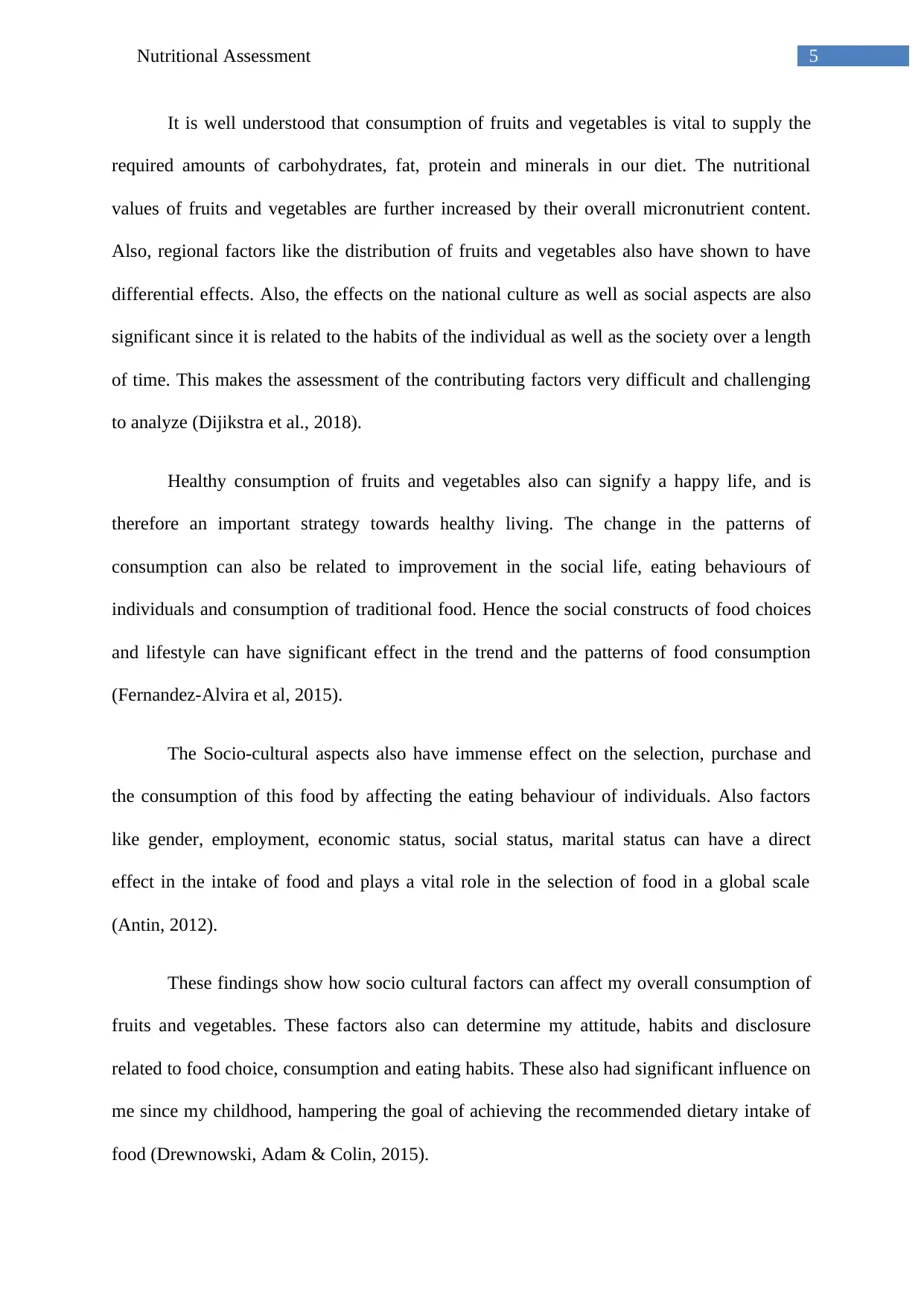
5Nutritional Assessment
It is well understood that consumption of fruits and vegetables is vital to supply the
required amounts of carbohydrates, fat, protein and minerals in our diet. The nutritional
values of fruits and vegetables are further increased by their overall micronutrient content.
Also, regional factors like the distribution of fruits and vegetables also have shown to have
differential effects. Also, the effects on the national culture as well as social aspects are also
significant since it is related to the habits of the individual as well as the society over a length
of time. This makes the assessment of the contributing factors very difficult and challenging
to analyze (Dijikstra et al., 2018).
Healthy consumption of fruits and vegetables also can signify a happy life, and is
therefore an important strategy towards healthy living. The change in the patterns of
consumption can also be related to improvement in the social life, eating behaviours of
individuals and consumption of traditional food. Hence the social constructs of food choices
and lifestyle can have significant effect in the trend and the patterns of food consumption
(Fernandez-Alvira et al, 2015).
The Socio-cultural aspects also have immense effect on the selection, purchase and
the consumption of this food by affecting the eating behaviour of individuals. Also factors
like gender, employment, economic status, social status, marital status can have a direct
effect in the intake of food and plays a vital role in the selection of food in a global scale
(Antin, 2012).
These findings show how socio cultural factors can affect my overall consumption of
fruits and vegetables. These factors also can determine my attitude, habits and disclosure
related to food choice, consumption and eating habits. These also had significant influence on
me since my childhood, hampering the goal of achieving the recommended dietary intake of
food (Drewnowski, Adam & Colin, 2015).
It is well understood that consumption of fruits and vegetables is vital to supply the
required amounts of carbohydrates, fat, protein and minerals in our diet. The nutritional
values of fruits and vegetables are further increased by their overall micronutrient content.
Also, regional factors like the distribution of fruits and vegetables also have shown to have
differential effects. Also, the effects on the national culture as well as social aspects are also
significant since it is related to the habits of the individual as well as the society over a length
of time. This makes the assessment of the contributing factors very difficult and challenging
to analyze (Dijikstra et al., 2018).
Healthy consumption of fruits and vegetables also can signify a happy life, and is
therefore an important strategy towards healthy living. The change in the patterns of
consumption can also be related to improvement in the social life, eating behaviours of
individuals and consumption of traditional food. Hence the social constructs of food choices
and lifestyle can have significant effect in the trend and the patterns of food consumption
(Fernandez-Alvira et al, 2015).
The Socio-cultural aspects also have immense effect on the selection, purchase and
the consumption of this food by affecting the eating behaviour of individuals. Also factors
like gender, employment, economic status, social status, marital status can have a direct
effect in the intake of food and plays a vital role in the selection of food in a global scale
(Antin, 2012).
These findings show how socio cultural factors can affect my overall consumption of
fruits and vegetables. These factors also can determine my attitude, habits and disclosure
related to food choice, consumption and eating habits. These also had significant influence on
me since my childhood, hampering the goal of achieving the recommended dietary intake of
food (Drewnowski, Adam & Colin, 2015).
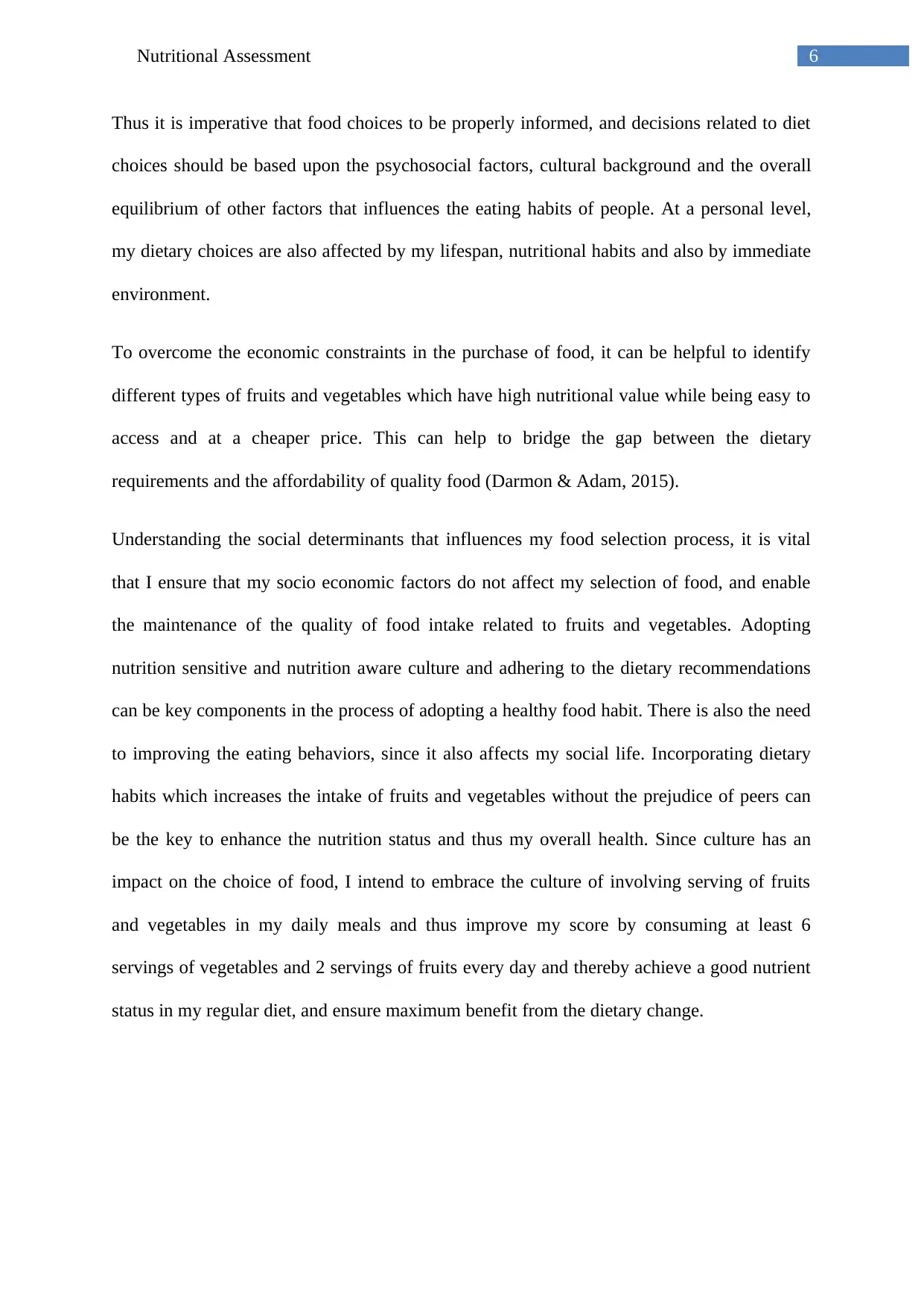
6Nutritional Assessment
Thus it is imperative that food choices to be properly informed, and decisions related to diet
choices should be based upon the psychosocial factors, cultural background and the overall
equilibrium of other factors that influences the eating habits of people. At a personal level,
my dietary choices are also affected by my lifespan, nutritional habits and also by immediate
environment.
To overcome the economic constraints in the purchase of food, it can be helpful to identify
different types of fruits and vegetables which have high nutritional value while being easy to
access and at a cheaper price. This can help to bridge the gap between the dietary
requirements and the affordability of quality food (Darmon & Adam, 2015).
Understanding the social determinants that influences my food selection process, it is vital
that I ensure that my socio economic factors do not affect my selection of food, and enable
the maintenance of the quality of food intake related to fruits and vegetables. Adopting
nutrition sensitive and nutrition aware culture and adhering to the dietary recommendations
can be key components in the process of adopting a healthy food habit. There is also the need
to improving the eating behaviors, since it also affects my social life. Incorporating dietary
habits which increases the intake of fruits and vegetables without the prejudice of peers can
be the key to enhance the nutrition status and thus my overall health. Since culture has an
impact on the choice of food, I intend to embrace the culture of involving serving of fruits
and vegetables in my daily meals and thus improve my score by consuming at least 6
servings of vegetables and 2 servings of fruits every day and thereby achieve a good nutrient
status in my regular diet, and ensure maximum benefit from the dietary change.
Thus it is imperative that food choices to be properly informed, and decisions related to diet
choices should be based upon the psychosocial factors, cultural background and the overall
equilibrium of other factors that influences the eating habits of people. At a personal level,
my dietary choices are also affected by my lifespan, nutritional habits and also by immediate
environment.
To overcome the economic constraints in the purchase of food, it can be helpful to identify
different types of fruits and vegetables which have high nutritional value while being easy to
access and at a cheaper price. This can help to bridge the gap between the dietary
requirements and the affordability of quality food (Darmon & Adam, 2015).
Understanding the social determinants that influences my food selection process, it is vital
that I ensure that my socio economic factors do not affect my selection of food, and enable
the maintenance of the quality of food intake related to fruits and vegetables. Adopting
nutrition sensitive and nutrition aware culture and adhering to the dietary recommendations
can be key components in the process of adopting a healthy food habit. There is also the need
to improving the eating behaviors, since it also affects my social life. Incorporating dietary
habits which increases the intake of fruits and vegetables without the prejudice of peers can
be the key to enhance the nutrition status and thus my overall health. Since culture has an
impact on the choice of food, I intend to embrace the culture of involving serving of fruits
and vegetables in my daily meals and thus improve my score by consuming at least 6
servings of vegetables and 2 servings of fruits every day and thereby achieve a good nutrient
status in my regular diet, and ensure maximum benefit from the dietary change.
Paraphrase This Document
Need a fresh take? Get an instant paraphrase of this document with our AI Paraphraser
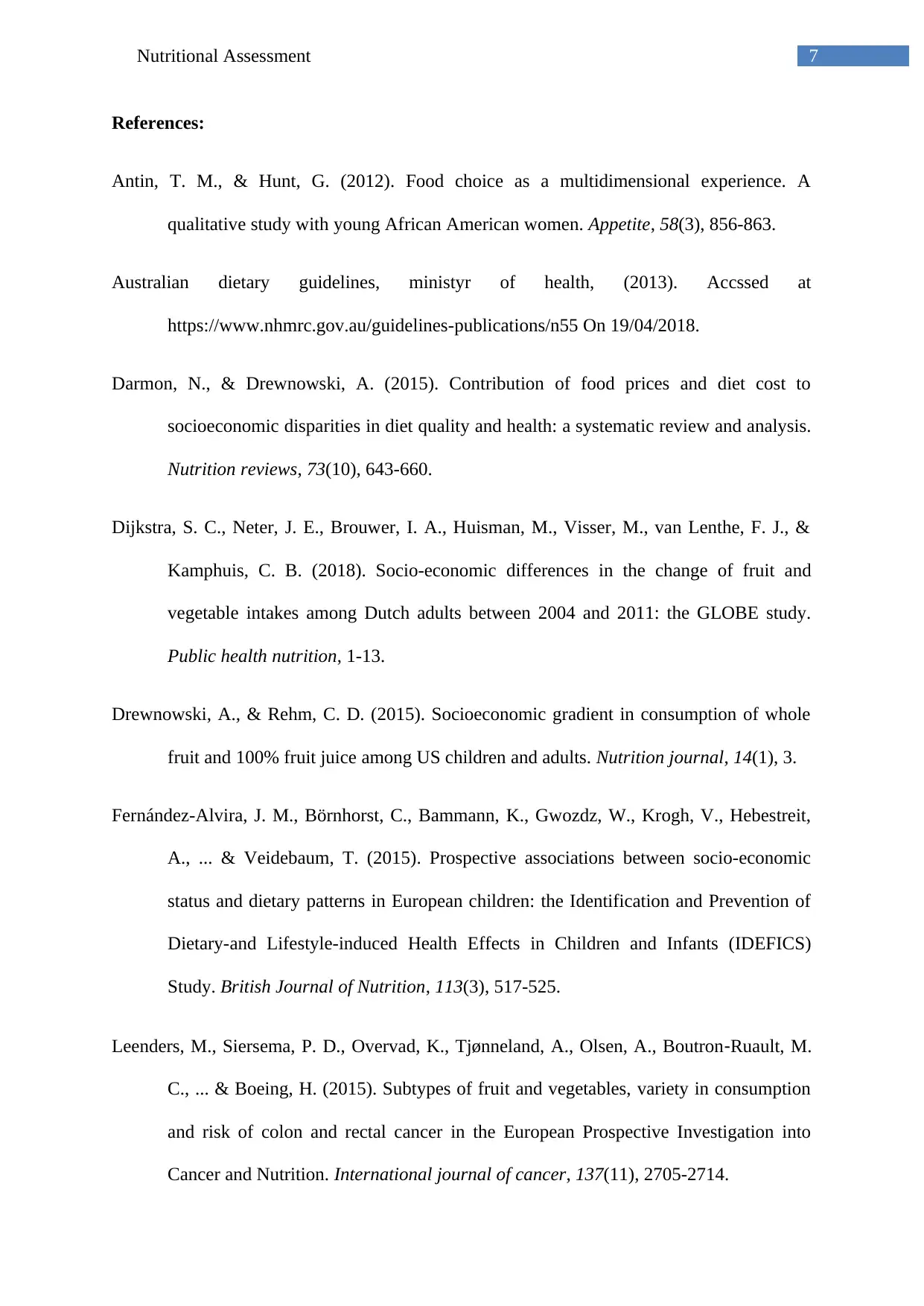
7Nutritional Assessment
References:
Antin, T. M., & Hunt, G. (2012). Food choice as a multidimensional experience. A
qualitative study with young African American women. Appetite, 58(3), 856-863.
Australian dietary guidelines, ministyr of health, (2013). Accssed at
https://www.nhmrc.gov.au/guidelines-publications/n55 On 19/04/2018.
Darmon, N., & Drewnowski, A. (2015). Contribution of food prices and diet cost to
socioeconomic disparities in diet quality and health: a systematic review and analysis.
Nutrition reviews, 73(10), 643-660.
Dijkstra, S. C., Neter, J. E., Brouwer, I. A., Huisman, M., Visser, M., van Lenthe, F. J., &
Kamphuis, C. B. (2018). Socio-economic differences in the change of fruit and
vegetable intakes among Dutch adults between 2004 and 2011: the GLOBE study.
Public health nutrition, 1-13.
Drewnowski, A., & Rehm, C. D. (2015). Socioeconomic gradient in consumption of whole
fruit and 100% fruit juice among US children and adults. Nutrition journal, 14(1), 3.
Fernández-Alvira, J. M., Börnhorst, C., Bammann, K., Gwozdz, W., Krogh, V., Hebestreit,
A., ... & Veidebaum, T. (2015). Prospective associations between socio-economic
status and dietary patterns in European children: the Identification and Prevention of
Dietary-and Lifestyle-induced Health Effects in Children and Infants (IDEFICS)
Study. British Journal of Nutrition, 113(3), 517-525.
Leenders, M., Siersema, P. D., Overvad, K., Tjønneland, A., Olsen, A., Boutron‐Ruault, M.
C., ... & Boeing, H. (2015). Subtypes of fruit and vegetables, variety in consumption
and risk of colon and rectal cancer in the European Prospective Investigation into
Cancer and Nutrition. International journal of cancer, 137(11), 2705-2714.
References:
Antin, T. M., & Hunt, G. (2012). Food choice as a multidimensional experience. A
qualitative study with young African American women. Appetite, 58(3), 856-863.
Australian dietary guidelines, ministyr of health, (2013). Accssed at
https://www.nhmrc.gov.au/guidelines-publications/n55 On 19/04/2018.
Darmon, N., & Drewnowski, A. (2015). Contribution of food prices and diet cost to
socioeconomic disparities in diet quality and health: a systematic review and analysis.
Nutrition reviews, 73(10), 643-660.
Dijkstra, S. C., Neter, J. E., Brouwer, I. A., Huisman, M., Visser, M., van Lenthe, F. J., &
Kamphuis, C. B. (2018). Socio-economic differences in the change of fruit and
vegetable intakes among Dutch adults between 2004 and 2011: the GLOBE study.
Public health nutrition, 1-13.
Drewnowski, A., & Rehm, C. D. (2015). Socioeconomic gradient in consumption of whole
fruit and 100% fruit juice among US children and adults. Nutrition journal, 14(1), 3.
Fernández-Alvira, J. M., Börnhorst, C., Bammann, K., Gwozdz, W., Krogh, V., Hebestreit,
A., ... & Veidebaum, T. (2015). Prospective associations between socio-economic
status and dietary patterns in European children: the Identification and Prevention of
Dietary-and Lifestyle-induced Health Effects in Children and Infants (IDEFICS)
Study. British Journal of Nutrition, 113(3), 517-525.
Leenders, M., Siersema, P. D., Overvad, K., Tjønneland, A., Olsen, A., Boutron‐Ruault, M.
C., ... & Boeing, H. (2015). Subtypes of fruit and vegetables, variety in consumption
and risk of colon and rectal cancer in the European Prospective Investigation into
Cancer and Nutrition. International journal of cancer, 137(11), 2705-2714.
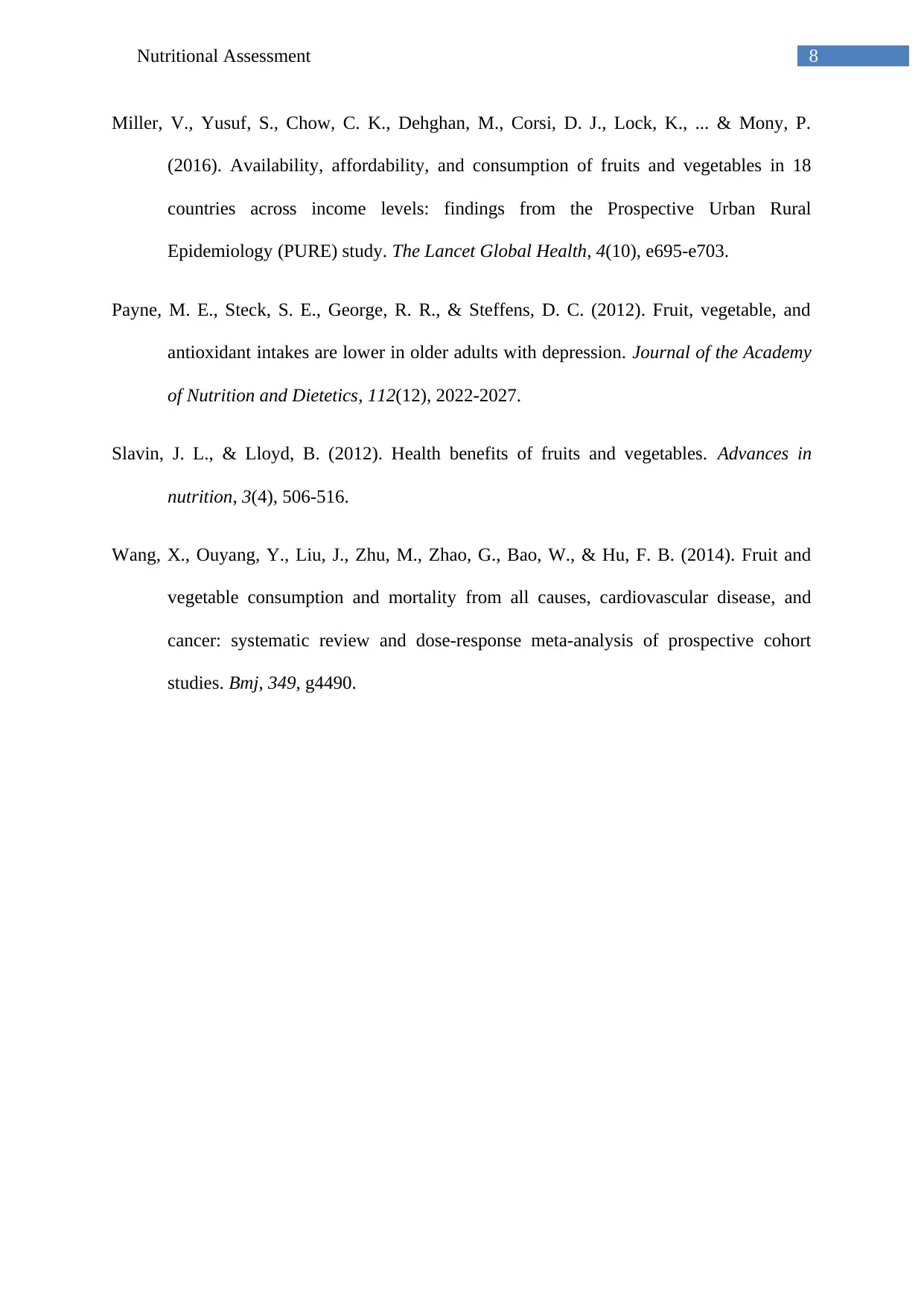
8Nutritional Assessment
Miller, V., Yusuf, S., Chow, C. K., Dehghan, M., Corsi, D. J., Lock, K., ... & Mony, P.
(2016). Availability, affordability, and consumption of fruits and vegetables in 18
countries across income levels: findings from the Prospective Urban Rural
Epidemiology (PURE) study. The Lancet Global Health, 4(10), e695-e703.
Payne, M. E., Steck, S. E., George, R. R., & Steffens, D. C. (2012). Fruit, vegetable, and
antioxidant intakes are lower in older adults with depression. Journal of the Academy
of Nutrition and Dietetics, 112(12), 2022-2027.
Slavin, J. L., & Lloyd, B. (2012). Health benefits of fruits and vegetables. Advances in
nutrition, 3(4), 506-516.
Wang, X., Ouyang, Y., Liu, J., Zhu, M., Zhao, G., Bao, W., & Hu, F. B. (2014). Fruit and
vegetable consumption and mortality from all causes, cardiovascular disease, and
cancer: systematic review and dose-response meta-analysis of prospective cohort
studies. Bmj, 349, g4490.
Miller, V., Yusuf, S., Chow, C. K., Dehghan, M., Corsi, D. J., Lock, K., ... & Mony, P.
(2016). Availability, affordability, and consumption of fruits and vegetables in 18
countries across income levels: findings from the Prospective Urban Rural
Epidemiology (PURE) study. The Lancet Global Health, 4(10), e695-e703.
Payne, M. E., Steck, S. E., George, R. R., & Steffens, D. C. (2012). Fruit, vegetable, and
antioxidant intakes are lower in older adults with depression. Journal of the Academy
of Nutrition and Dietetics, 112(12), 2022-2027.
Slavin, J. L., & Lloyd, B. (2012). Health benefits of fruits and vegetables. Advances in
nutrition, 3(4), 506-516.
Wang, X., Ouyang, Y., Liu, J., Zhu, M., Zhao, G., Bao, W., & Hu, F. B. (2014). Fruit and
vegetable consumption and mortality from all causes, cardiovascular disease, and
cancer: systematic review and dose-response meta-analysis of prospective cohort
studies. Bmj, 349, g4490.
1 out of 9
Related Documents
Your All-in-One AI-Powered Toolkit for Academic Success.
+13062052269
info@desklib.com
Available 24*7 on WhatsApp / Email
![[object Object]](/_next/static/media/star-bottom.7253800d.svg)
Unlock your academic potential
© 2024 | Zucol Services PVT LTD | All rights reserved.





